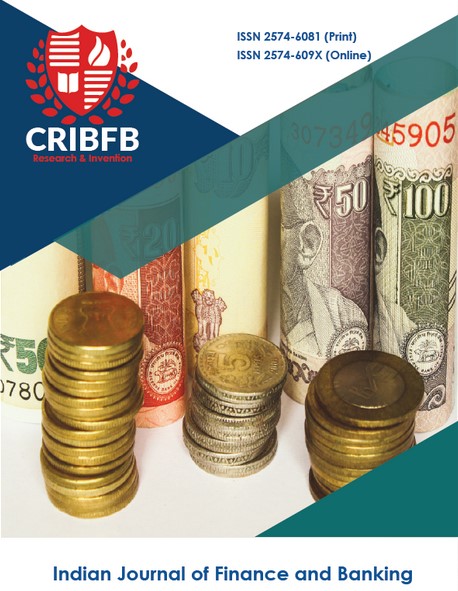LEVERAGE INDUCED FINANCIAL DISTRESS OF MANUFACTURING FIRMS IN BANGLADESH: A COMPARISON BETWEEN LISTED MNCS AND DOMESTIC FIRMS BY APPLYING ALTMAN’S Z SCORE MODEL
Main Article Content
Abstract
Financial distress arises from excessive debt capital. The purpose of the study was to determine Altman's Z score and analyze as well as compare the effect of debt on Z scores of listed MNCs & domestic companies of Bangladesh over 24 years (1996-2019). The study was based on secondary data. Seven local companies and seven MNCs were selected as a sample from six manufacturing industrial sectors. It was found that on average one local firm was in the grey zone and the rest 13 firms were in the safe zone (Z scores>2.99). MNCs’ Z scores were significantly higher than that of domestic companies. The grand mean of the Z score of MNCs was 5.398 while that of domestic companies was 4.155. In the case of domestic companies, Z score changes by 0.01 or 0.24% for a 1% change of total debt in opposite direction. MNCs’ Z score decreases by 0.005 or 0.073% for a 1% increase of total debt. Domestic companies should increase Z score by redesigning the capital structure and improving basic earning power. The study has practical implications for corporate managers, policymakers, investors, and government because future strategy, policy, and business performance depend on the zone in which the firms are situated.
JEL Classification Codes: G30, G32, G39.
Downloads
Article Details
Section
How to Cite
References
Afrina, T., Beg, T. H., Zayed, N. M., Hossain, M. S., & Shahi, S.H. (2020). An analysis of the effects of corona virus (COVID-19) on international financial derivatives market, 2020. Indian Journal of Finance and Banking, 4(2), 93-98. https://doi.org/10.46281/ijfb.v4i2.757
Akani, H. W., & Ifechi, K. N. J. (2017). Effects of capital structure and board structure on corporate performance of selected firms in Nigeria. Indian Journal of Finance and Banking, 1(2), 1-16. https://doi.org/10.46281/ijfb.v1i2.85
Ali, M. R., Rahman, M. M., & Mahmud, M. S. (2016). Financial soundness of textile industry: Altman Z-score measurement. Journal of Science and Technology, 14, 8-17. Retrieved from https://jst.hstu.ac.bd/assets_vcc/files/vol_14/2_14_jst_15-18.pdf
Altman, E. I. (1993). Corporate Financial Distress and Bankruptcy. New York: John Wiley & Sons, ch.3, quoted in Stephen H. Penman, Financial Statement Analysis and Security Valuation (3rd ed.). New Delhi, India: Tata McGraw-Hill Publishing Co. Ltd., 2008, p. 730.
Altman, E. I. (1983). Corporate Financial Distress: A Complete Guide to Predicting, Avoiding and Dealing with Bankruptcy. New York: John Wiley & Sons.
Anjum, S. (2012). Business bankruptcy prediction models: A significant study of the Altman’s Z-score model. Asian journal of management research, 3(1), 212-219.
Barman, B. (2020, April 25). Most MNCs see surge in 2019 earnings. The Financial Express. Retrieved from https://www.thefinancialexpress.com.bd/stock
Black’s Law Dictionary, 5th ed. (St. Paul Minn.: West Publishing Company), 716, quoted in Ross, Westerfield, and Jaffe, Corporate Finance, 830-831.
Brealey, R. A., & Myres, S. C. (1996). Principles of Corporate Finance (5thed.). New York: McGraw Hill Companies, pp. 484-486.
Egbunike, F. C., Ogbodo, C. O., & Ojimadu, J. O. (2019). The Effect of Financial Distress on Corporate Profitability: A Panel Estimated Generalized Least Squares (EGLS) Approach. Journal of Global Accounting, 6(1), 24-44. Retrieved from http://unizikjga.com/PDF-files/Volume-6-No-1-2019/24-44.pdf
Gopalakrishnan, M. M., Gupta, A., Raja, M., Reddy, R. V., & Subbarao, A. N. (2019). Bankruptcy prediction for steel industry in India using Altman Z score model. International Journal of Production Technology and Management (IJPTM), 10(1), 87–102. Retrieved from http://www.iaeme.com/ijptm/issues.asp?JType=IJPTM&VType=10&IType=1
Hillary, O. K., Nyang’au, A., & Ngacho, C. (2018). Effects of financial distress on financial performance of manufacturing firms listed in Nairobi securities exchange. International Journals of Academics & Research, 1(1), 211-220. Retrieved from https://storage.googleapis.com/wzukusers/user-34065638/documents/5bc8e45629b7faM6CRmb/19-IBM%20Journals%20Vol1%20Issue1%2019.pdf
Iheduru, N. G., & Okoro, C. U. (2018). Macroeconomic variables and retained earnings of quoted manufacturing firms in Nigeria: A time variant study. International Journal of Accounting & Finance Review, 3(1), 33-47. https://doi.org/10.46281/ijafr.v3i1.29
Ikpesu, F., & Eboiyehi, O. C. (2018). Capital structure and corporate financial distress of manufacturing firms in Nigeria. Journal of Accounting and Taxation, 10(7), 78-84. http://dx.doi.org/10.5897/JAT2018.0309
Jahur, M S., & Quadir, S. (2012). Financial distress in small and medium enterprises (SMEs) of Bangladesh: Determinants and remedial measures. Economia: Seria Management, 15. Retrieved from https://www.researchgate.net/publication/254449281
Janardhanan, A. K., & Uma, V. R. (2020). The role of internal control and firm-specific characteristics on firm value: Evidence from Indian financial services sector. Indian Journal of Finance and Banking, 4(1), 117-133.
Khaddafi, M., Falahuddin, Heikal, M., & Nandari, A. (2017). Analysis Z-score to predict bankruptcy in banks listed in Indonesia stock exchange. International Journal of Economics and Financial Issues, 7(3), 326-330.
Masum, A. A., & Johora, F. T. (2012). Performance evaluation of selected ceramic companies of Bangladesh. Asian Business Review, 1(1), 37-48. Retrieved from http://oaji.net/articles/2014/800-1398835441.pdf
Mizan, A. N. K., & Hossain, M. M. (2014). Financial soundness of cement industry of Bangladesh: An empirical investigation using Z-score. American Journal of Trade and Policy, 1(1), 16-22.
Mizan, A. N. K., Amin, M. R., & Rahman, T. (2011). Bankruptcy prediction by using the Altman Z-score model: An investigation of the pharmaceutical industry in Bangladesh. Bank Parikrama, 36(2-4), 33-56.
New Age (2019, May 18). Most of MNCs post higher profits in 2018.Retrieved from https://www.newagebd.net/article/72729
Pradhan, R. (December, 2014). Z score estimation for Indian banking sector. International journal of trade, economics and finance, 5(6), 516-520. http://dx.doi.org/10.7763/ IJTEF.2014.V5.425
Ross, S. A., Westerfield, R. W., & Jordan, B. D. (2002). Fundamentals of Corporate Finance (6th ed.). New Delhi: Tata McGraw-Hill Publishing Co. Ltd., pp. 586-590.
Sadiq, A. I., Kachollom, P. W., Dasuki, S. I., & Yusuf, M. (2017). Effect of capital structure on the performance of deposit money banks. International Journal of Accounting & Finance Review, 1(1), 12-23. https://doi.org/10.46281/ijafr.v1i1.14
Sajjan, R. (April, 2016). Predicting bankruptcy of selected firms by applying Altman’s Z-score model. International journal of research-Granthaalayah, 4(4), 152-158.




